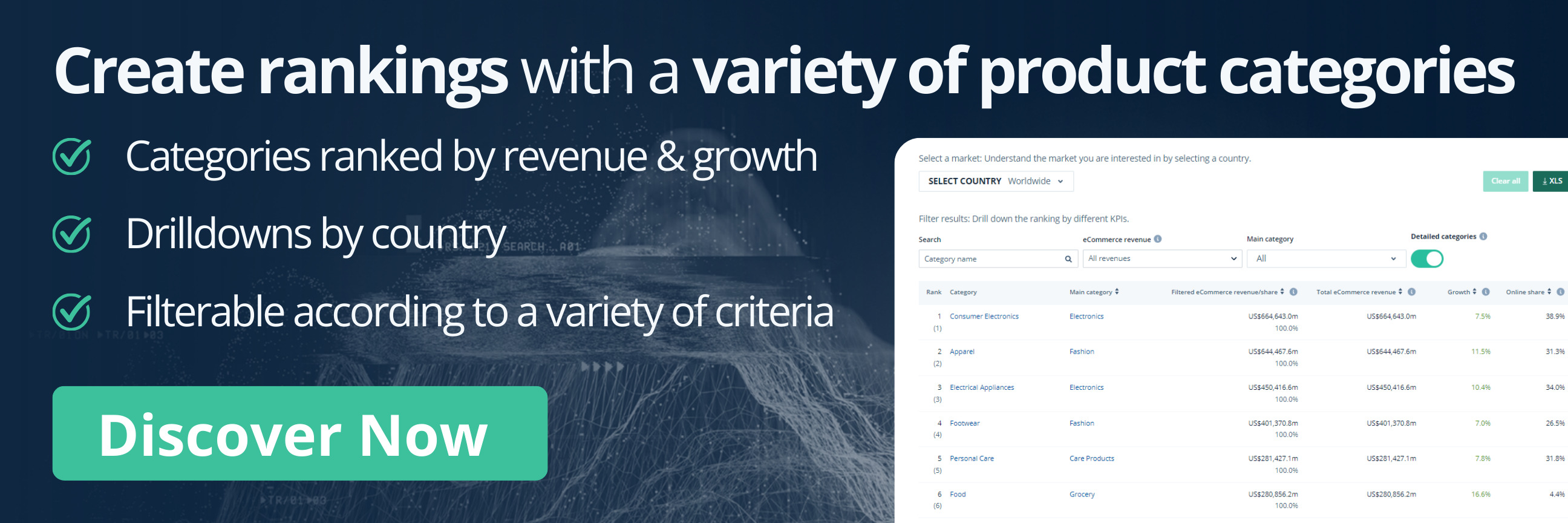eCommerce: Demographic Analysis
Gen Z Online Shopping Behavior: Consumer Habits, Preferences & Trends
Gen Z online shoppers are special in the sense that most of them only know life with the internet. How does that influence how they shop online?
Article by Nadine Koutsou-Wehling | October 24, 2024Download
Coming soon
Share

Gen Z Online Shopping Behavior: Key Insights
Defining Gen Z: Common definitions place Gen Z between 1997 and 2010.
Online Shopping Habits: Gen Z online shoppers typically place a high value on sustainable shopping (like reCommerce), are likely to use social commerce, respond to influencer marketing, and pay digitally.
Spending Power: Because Gen Z is the largest generation currently, its projected spending power is at US$12 trillion by 2030.
Gen Z’s online shopping behavior is truly unique. This generation dictates trends with a single TikTok or Instagram post, leaving brands scrambling to keep up. Imagine scrolling through your feed, discovering a must-have item, and sharing it with your friends – this is shopping for them.
Through social media, Gen Z merges self-expression with consumerism. How can the market adapt to this? How can brands leverage these insights? While it’s a challenge yet to be solved, this data can help guide the way.
Who Is Gen Z?
Although the threshold varies depending on the approach used, the most common starting point for the birth of Gen Z is 1997. What is unique about Gen Z is that all of the disruptive technologies of the past (television, computers, and the internet) have been a part of their lives from the beginning.
Social media and constant connectivity, which allow for on-demand entertainment that previous generations have not experienced, are second nature to Gen Z. In turn, these preferences and experiences shape how Gen Z likes to shop online, how they use media and devices, and which brands they tend to choose.
The end of Gen Z is between 2010 and 2012, when Gen Alpha starts. Before Gen Z, 1996 and earlier, are the Millennials. But what are the specific characteristics of Gen Z that define how they behave as online shoppers?
Gen Z: Online Shopping Habits
Because of the widespread connectivity enabled by the internet, which spans continents rather than local communities, Gen Z is considered the most socially conscious generation yet. Societal issues are global, it has become easier to share an opinion publicly, and so common points of discussion shape the way Gen Z processes information about global events.
Discover Our Data: Our frequently updated rankings provide essential insights to help your business thrive. Wondering which stores and companies are excelling in eCommerce? Interested in the top-performing categories? Find the answers in our rankings for companies, stores, and marketplaces. Stay competitive with ECDB.
As a result, the following online shopping preferences are typical of Gen Z. They are influenced by Gen Z’s widespread social consciousness, exposure to digital media, and ease of use.
1. Sustainable Shopping
Sustainable online shopping includes multiple forms of eCommerce. The most prevalent is reCommerce, but it can also mean shopping for sustainable products that are recycled, recyclable, or made from environmentally friendly materials, or stores with packaging strategies that focus on reducing waste.
Staying with the first aspect, reCommerce, the propensity of U.S. online shoppers to engage is growing with the younger generations. In a Statista survey, Gen Z respondents were the most likely to say they had bought items secondhand, with a 70% agreement rate. Older generations were less inclined.
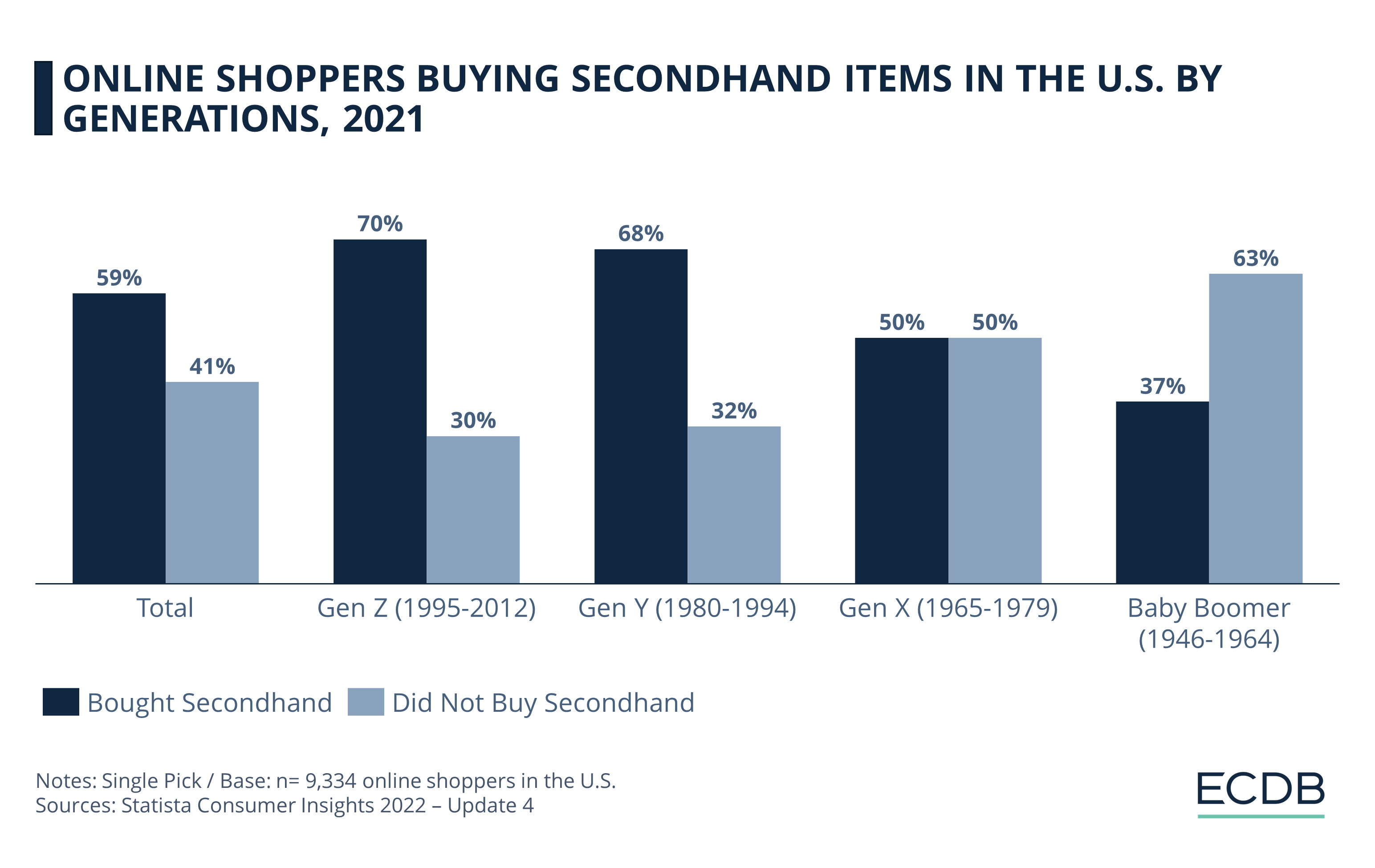
Although reCommerce is the online purchase of secondhand products, it is predicated on a general willingness to buy used products. While Gen Y is almost as likely as Gen Z to buy secondhand, at 68%, Gen X respondents are less likely, at 50%. Baby Boomers are the least likely, at 37%.
Platforms like Vinted, Depop, Vestiaire Collective, and the RealReal make it easy for users to both sell and buy pre-loved items. Since the concept is still quite new and emerging, there are issues that need to be addressed in the long run for reCommerce to work.
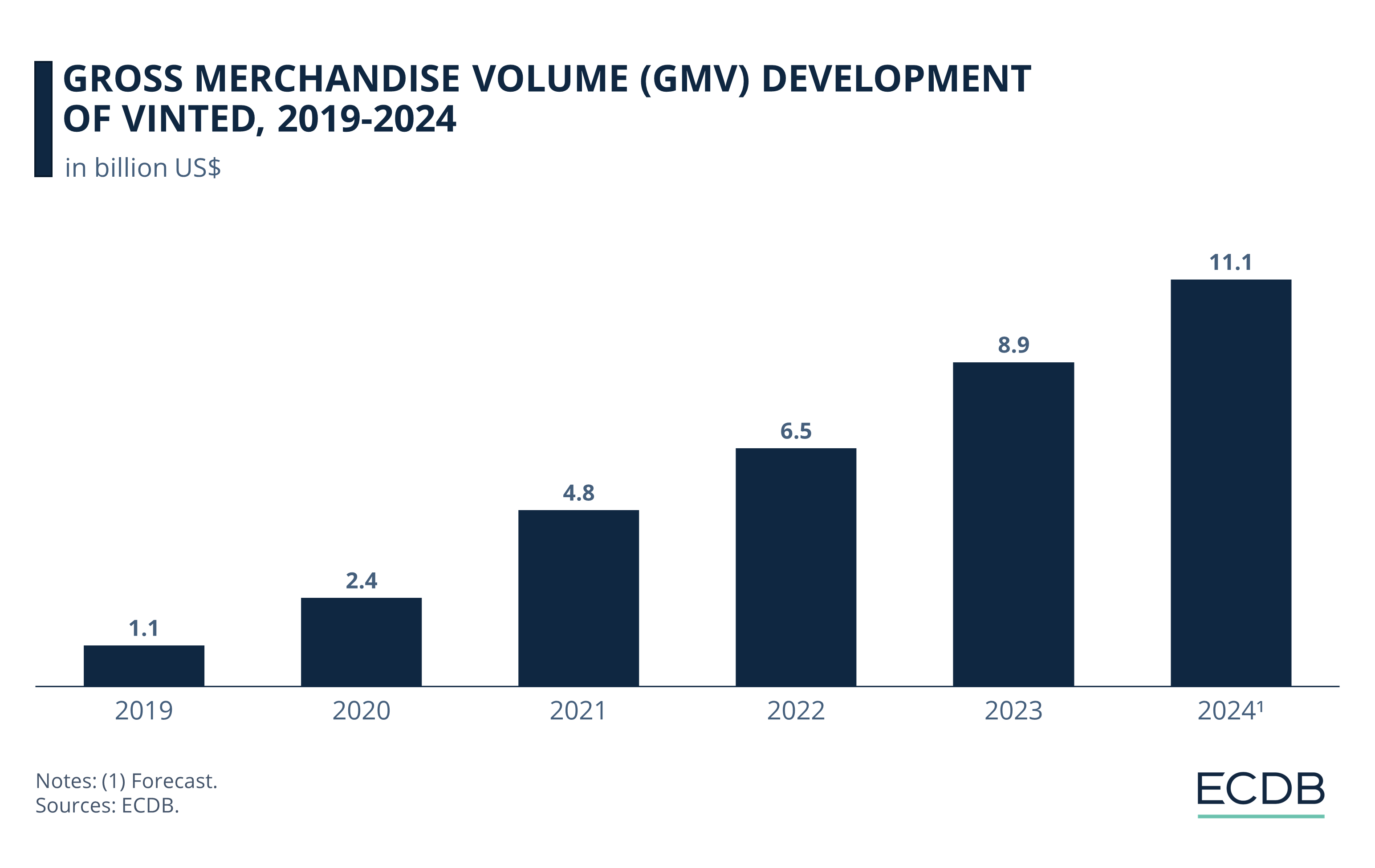
But beware, there can be a disconnect between stated values and actual behavior. This sometimes leads to verbal support of a lifestyle that consumers do not necessarily follow themselves. This phenomenon is known as the consumer paradox. In fashion, it is called the fashion paradox. It is exacerbated by the complexity of supply chains and the difficulty of finding suppliers who can deliver stylish and sustainable trends at affordable prices.
2. Mobile Access Facilitates Social Commerce
Social commerce is the purchase of products on social media platforms. It is still in its developing stages and is being adopted differently across world regions. When it comes to generational usage, Gen Z tends to be the most likely to shop via social commerce.
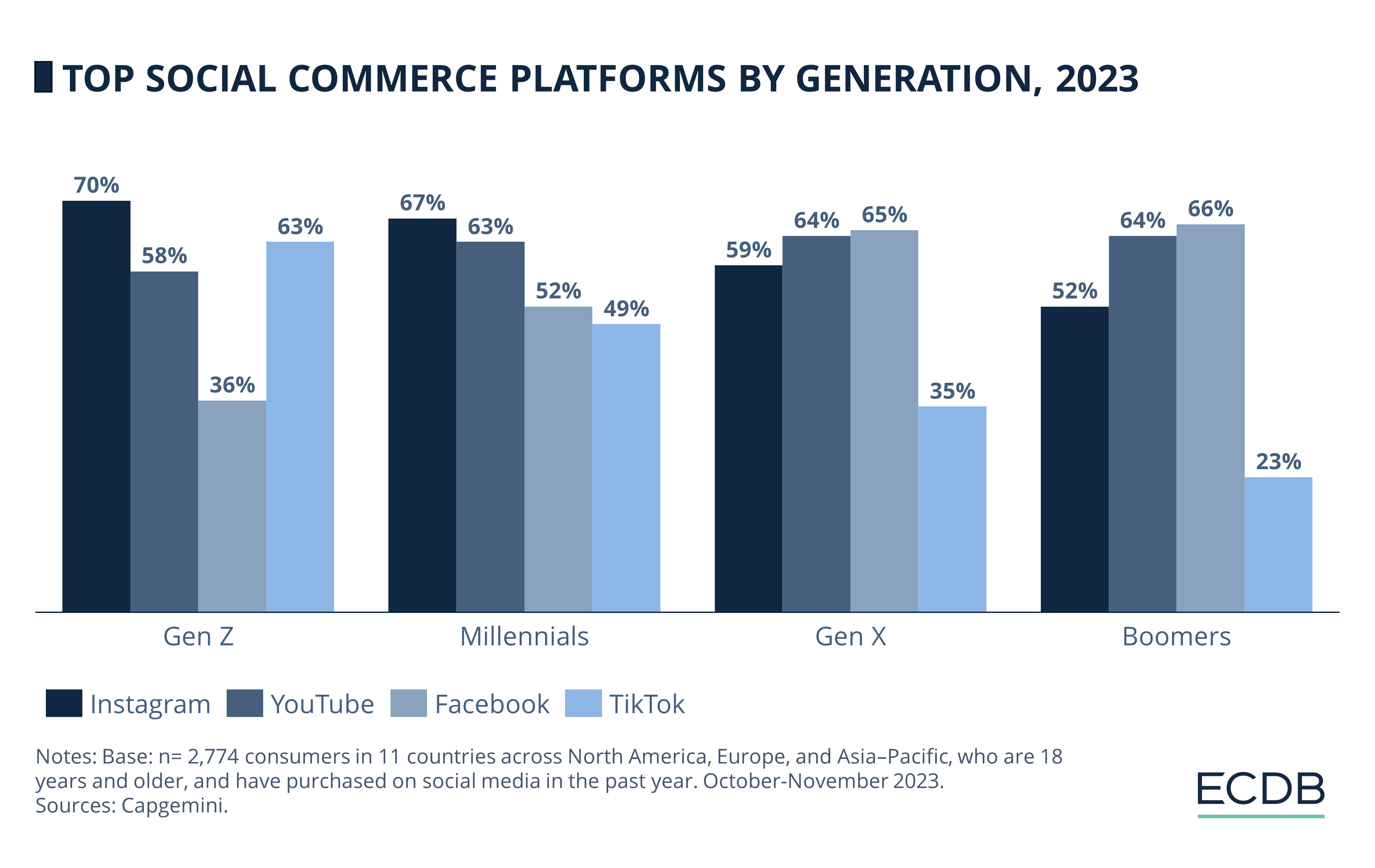
Instagram and TikTok are Gen Z’s preferred social commerce platforms: 70% of Gen Z users have bought products on Instagram, and 63% on TikTok. For these two platforms, Gen Z users are the best customers of any generation.
YouTube and Facebook are less popular With Gen Z: YouTube tends to be a longer-form video platform, so it's generally not as popular as TikTok with younger users, while Facebook is used more by older cohorts.
As Gen Z is highly proficient with mobile devices, using them frequently and for all aspects of life, online shopping is one of those activities. The appeal of social commerce is the ease with which users can click through to purchase a product they see on a site. For Gen Z shoppers, who tend to be more immersed in social media platforms, the likelihood of buying a product would be similarly high. This can even take involuntary forms, such as consumers compulsively buying to feel better.
3. Influencer Marketing
Influencer marketing is closely linked to social media. Accordingly, Gen Z users who are more likely to use social media frequently from an early age would be more influenced by the personalities on platforms who are promoting the products. The effect should not be underestimated, as influencers become role models for users who trust their judgment and want to emulate their lifestyle. The fact that an ad is sometimes indistinguishable from a regular post blurs the lines between entertainment and shopping.
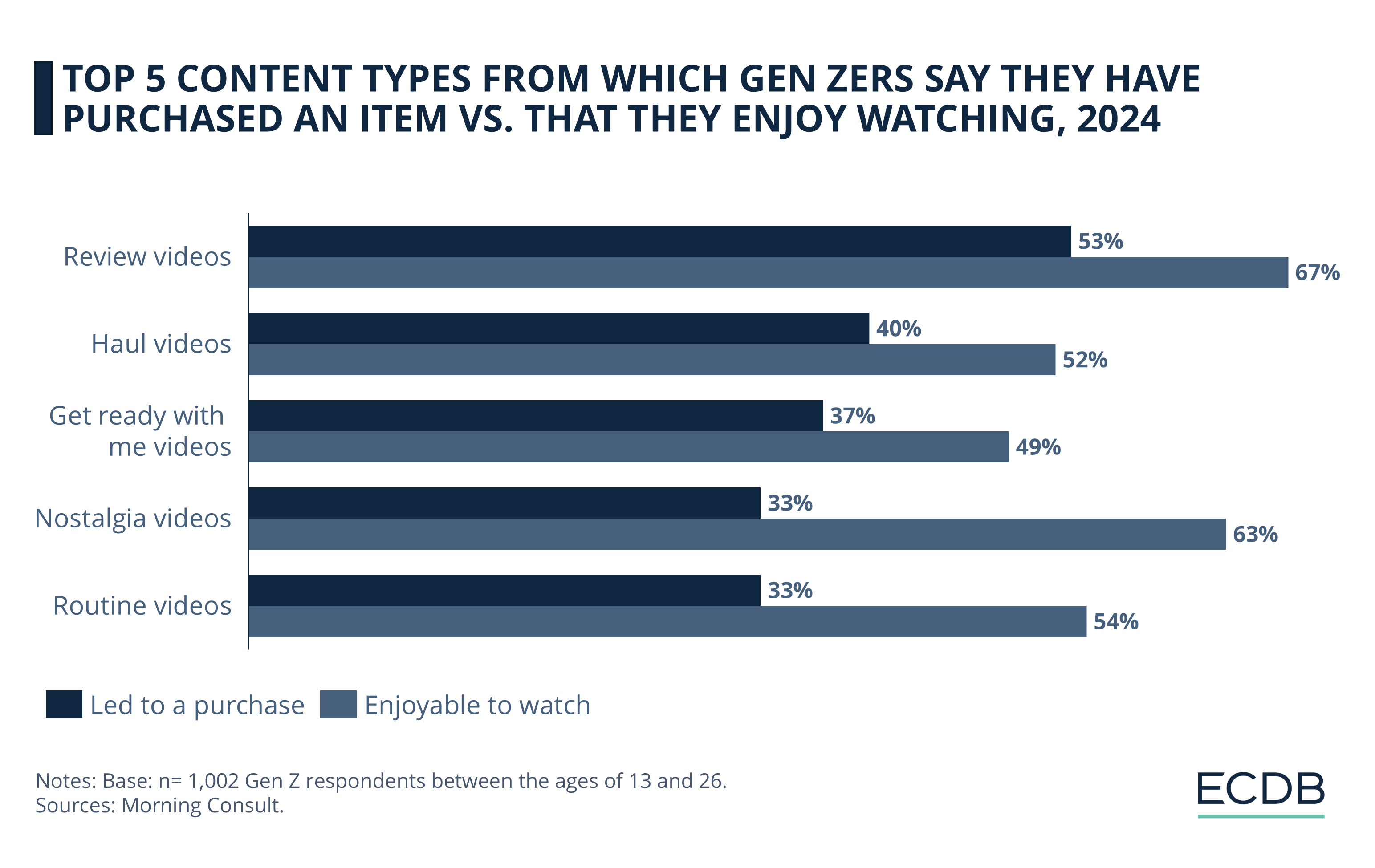
Review videos: Of the top content types that Gen Z consumers say they have purchased a product from, review videos are the number one type at 53%. While 67% of respondents say they enjoy watching review videos, it makes sense that this would be the most popular type of content for shopping, as it helps users make a purchase decision by examining the product in more detail.
Haul videos: A haul video comes in second at 40%. It is similar to a review, but does not go into as much detail about the product. Rather, haul videos show the unboxing of a purchase, and are sometimes just satisfying to watch for the opening of a beautiful package or the sheer size of the order. As a result, 52% of Gen Z users say they watch this type of content for fun. Popular brands like Shein tend to use this method to promote their brand and inspire purchases.
Get ready with me (GRWM) videos: GRWM content has led 37% of Gen Z respondents to make a purchase. This most often involves fashion or beauty products. Watching videos for makeup inspiration or how to pull off an outfit is quite widespread, and is watched for fun by 49% of respondents.
Nostalgia videos: One-third of Gen Z users say they have purchased a product from nostalgia videos, which showcase products used in the past, such as toys, video consoles, and general aesthetics. While these videos are more likely to be watched for entertainment (63%), they do have some potential to drive conversions. Especially if the styles and technology respond to a current trend, users will buy in bulk.
Routine videos: Just as likely as the previous category, nostalgia videos, routine videos inspire 33% of users to buy a product. Similar to “day in the life” content, routine videos show someone getting up in the morning, preparing a meal, or going to bed at night. While 54% of users enjoy watching these types of videos for the entertainment and sense of familiarity they provide, it is also a way to promote products.
Now that we know how users learn about products online, the next step is to examine how they typically prefer to pay for their orders. Spoiler alert: convenience is key.
4. Mobile Payments, eWallets and BNPL
Along with Millennials, Gen Z users tend to respond quite positively to mobile payments and eWallets, like PayPal, Apple Pay, Google Pay and Amazon Pay. These types of payments use credit card or bank information to make purchases with a single click. They greatly simplify the online shopping process, which can become a hassle if the right payment method is not available.
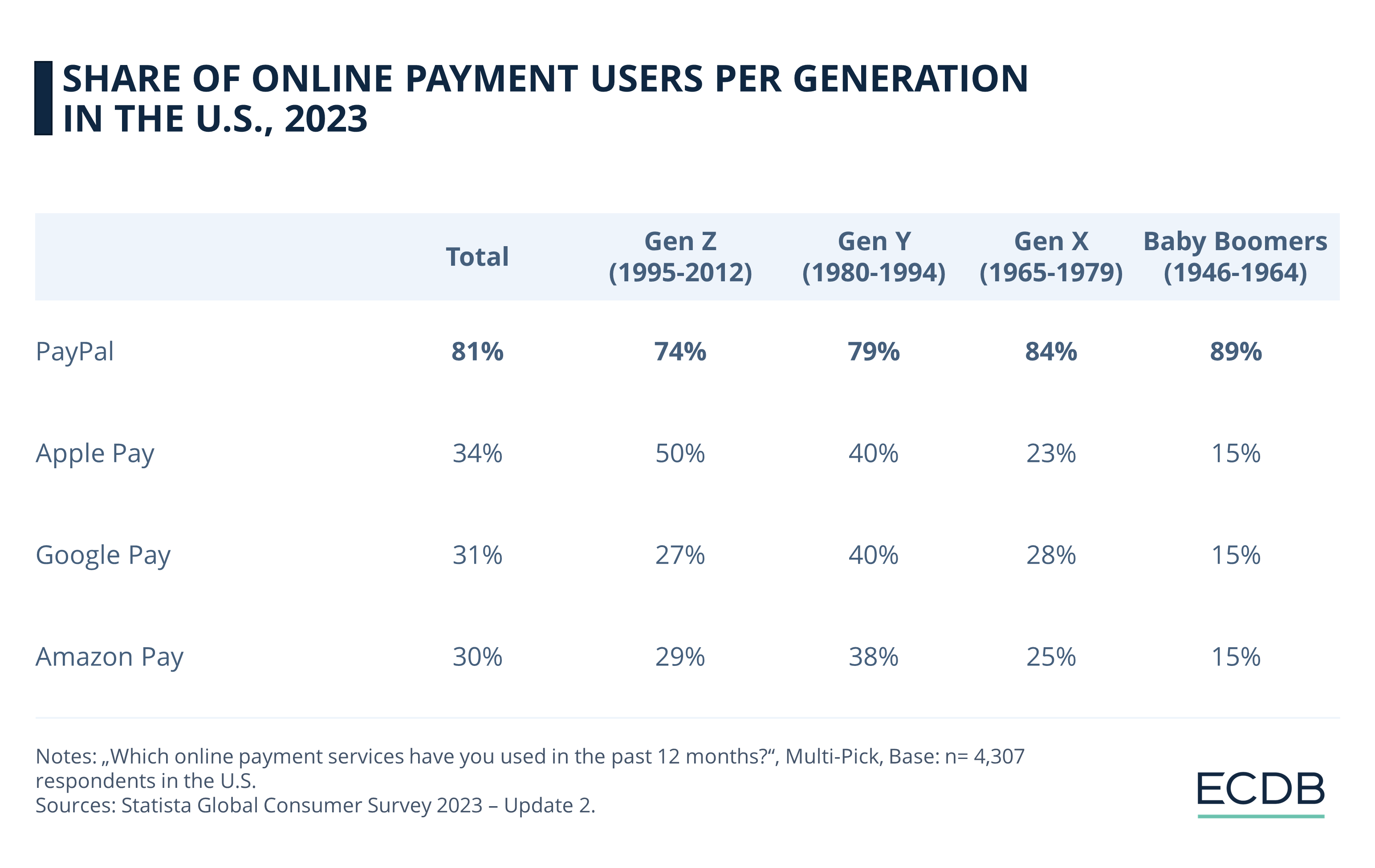
Gen Z Spending Power & Top Categories
Gen Z is currently the largest generation in the world. Marketing research firm Nielsen IQ estimates that Gen Z currently makes up 25% of the global population. By 2030, their spending power is expected to be at US$12 trillion.
For global Gen Z shoppers, the product categories they prefer to buy online are clothing and footwear, electronics, entertainment, adult products, jewelry, and sport & leisure. This is according to Klarna Insights.
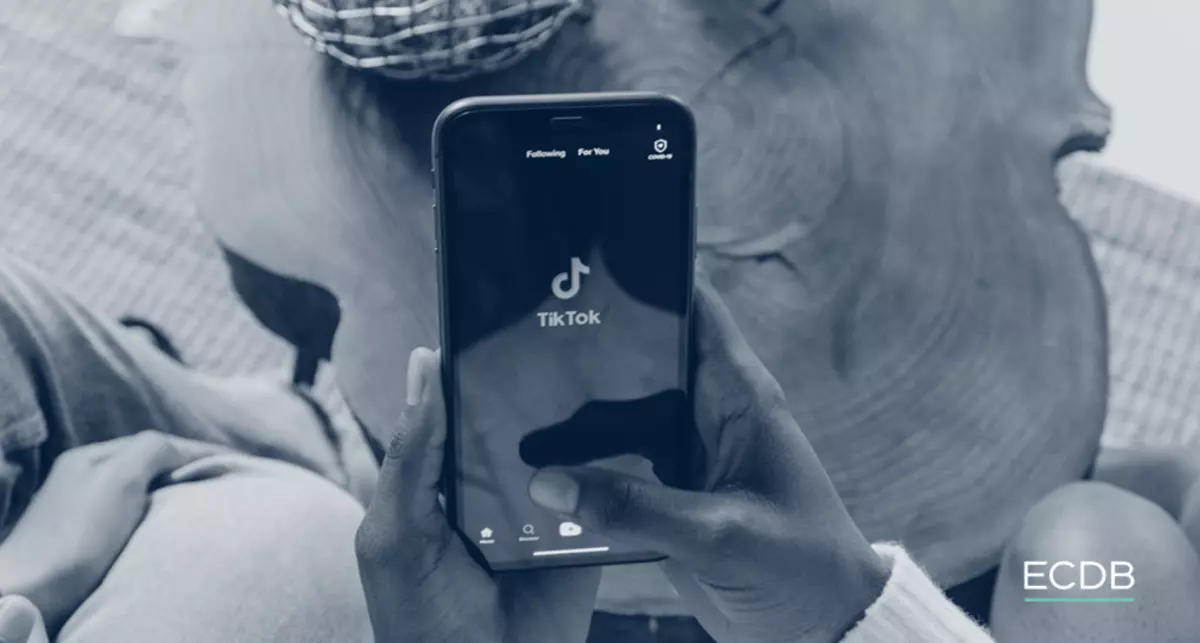
Outlook: Gen Z Online Shopping Habits
As a digitally native generation, the best way for retailers to reach Gen Z online shoppers is to meet them where they are. Combining shopping with entertainment, such as promoting products through trending content types, makes sense to engage consumers. Gen Z consumers also tend to care about the broader impact of their purchases, although the consumer paradox means that sometimes talk is cheap.
Popular companies among youngsters include Nike, a socially conscious brand, and Shein, a not so socially conscious brand. It shows that trends and styles at low prices sometimes go a long way, but there is no guarantee that Gen Z users will order from Shein with the same fervor as they get older.
Sources: NIQ – Pew Research Center

Click here for
more relevant insights from
our partner Mastercard.
Related insights
Deep Dive
Next Generation eCommerce: Key Trends Shaping the New Age of Online Retail
Next Generation eCommerce: Key Trends Shaping the New Age of Online Retail
Deep Dive
Google's AI Project Jarvis Could Change Online Shopping
Google's AI Project Jarvis Could Change Online Shopping
Deep Dive
The Customer Journey in Online Shopping: It Begins with Search Engines
The Customer Journey in Online Shopping: It Begins with Search Engines
Deep Dive
TikTok Shop Expands Operation in the United States
TikTok Shop Expands Operation in the United States
Deep Dive
Fast Fashion Online Market: Fast Fashion Is Not Fair Fashion
Fast Fashion Online Market: Fast Fashion Is Not Fair Fashion
Back to main topics
